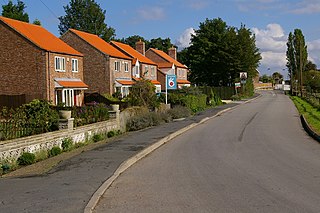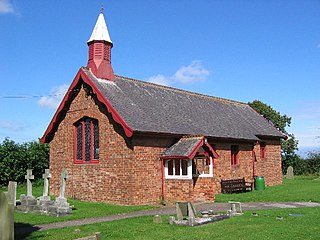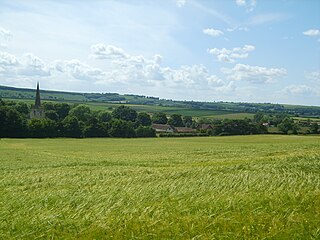
Withernsea is a seaside resort town and civil parish in Holderness, East Riding of Yorkshire, England. Its white inland lighthouse, rising around 127 feet (39 m) above Hull Road, now houses a museum to 1950s actress Kay Kendall, who was born in the town.

Garton on the Wolds is a village and a civil parish on the Yorkshire Wolds in the East Riding of Yorkshire, England. It is situated approximately 3 miles (5 km) north-west of Driffield town centre and lies on the A166 road.

Harpham is a small village and civil parish in the East Riding of Yorkshire, England. It is located just south of the A614 road, approximately 5 miles (8 km) north-east of Driffield and 7 miles (11 km) south-west of Bridlington.

Wressle is a village and civil parish in the East Riding of Yorkshire, England, lying on the eastern bank of the River Derwent approximately 3 miles (5 km) north-west of Howden.

Bainton is a village and civil parish in the East Riding of Yorkshire, England. It is situated approximately 6 miles (10 km) south-west of Driffield on the A614 road.

Bewholme is a village and civil parish in the East Riding of Yorkshire, England. It is situated approximately 3 miles (4.8 km) north-west of the town of Hornsea.

Swanland is a village and civil parish in the East Riding of Yorkshire in England. The village is about seven miles (11 km) to the west of Kingston upon Hull city centre and two miles (3.2 km) north of the Humber Estuary in the foothills of the Yorkshire Wolds on the B1231 road.

Yapham is a village and civil parish in the East Riding of Yorkshire, Northern England. It is situated about 2 miles (3.2 km) north-east of Pocklington. The parish includes the hamlet of Meltonby and is approximately 1,830 acres (740 ha).

Wintringham is a village and civil parish in North Yorkshire, England. The village is near the A64 road and 6 miles (9.7 km) east of Malton.

Skeffling is a village and civil parish in the East Riding of Yorkshire, England, in an area known as Holderness. It is situated approximately 5 miles (8 km) south of the town of Withernsea and 4 miles (6.4 km) south-east of the village of Patrington on the B1445 road from Patrington to Easington.

Thomas Atkinson (1729–1798) was an English architect, best remembered for remodelling Bishopthorpe Palace in the Gothic Revival style.

St Patrick's Church, Patrington is an Anglican parish church located in Patrington, East Riding of Yorkshire, England. The church is a Grade I listed building.

The East Riding of Yorkshire is a local government district with the status of a unitary authority. For ceremonial purposes it includes the neighbouring city and unitary authority of Kingston upon Hull.

The Church of St Mary the Virgin, Masham, is the parish church in the town of Masham, North Yorkshire, England. The church stands on the site of an Anglo-Saxon place of worship with some the original Saxon stones incorporated into the current church. Archaeology has determined that the site has been used as a place of Christian worship for over 1,400 years.

The Church of All Saints, is the church for the village and parish of Skipsea, in the East Riding of Yorkshire, England. The church dates back to the late 11th/early 12th century and was the religious house tied to Skipsea Castle, which lay just to the west in Skipsea Brough. A causeway, to the north of the church, used to link it with the castle motte across what was Skipsea Bail Mere. The village continued developing long after the castle had been demolished c. 1221, and the church became the house of worship for Skipsea.

The Church of St Lambert, Burneston, is the Anglican parish church for the village of Burneston in North Yorkshire, England. The church was built progressively in the 14th, 15th and 16th centuries, with some later additions and is now a grade I listed structure. It is the only Anglican church in England to be dedicated to St Lambert, and one of its former vicars, Canon John Hartley, was noted for being a winner at the Men's Singles championship at Wimbledon two years running.

The Church of St Andrew is an Anglican parish church in the village of Kildwick, North Yorkshire, England. A church has been in Kildwick since at least 950 AD, though the current structure dates back to the 16th century, but in its oldest parts are c. 12th century. The church was one of only two being recorded in Craven at the time of the Domesday survey, and was historically known as the Lang Kirk of Craven as it is unusually long for a parish church. It has a split graveyard, with a small portion to the north of the Leeds Liverpool Canal, and the larger graveyard to the south of the canal surrounding the church.

The Church of St Oswald, Thornton Steward is an Anglican church to the west of the village of Thornton Steward in North Yorkshire, England. St Oswald's is thought to be one of the oldest churches in Wensleydale. It was mentioned in the Domesday Book, and has Norman origins. The building is located in a burial plot dating back as far as the 7th century, and is now a grade II* listed structure.

The Church of St Mary the Virgin is a grade II listed building in the village of Thornton Watlass, North Yorkshire, England. The tower dates back to the 15th century, but the rest of the church was entirely rebuilt in the 1860s, reopening in December 1867. The church forms part of the Benefice of Bedale, along with the Church of St Gregory (Bedale), the Church of John the Baptist (Leeming), and Burrill Mission Church.




















